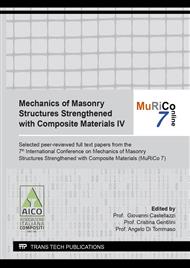[1]
M. Valente, G. Milani, Earthquake-induced damage assessment and partial failure mechanisms of an Italian Medieval castle,, Eng. Fail. Anal., 99, 292-309, (2019).
DOI: 10.1016/j.engfailanal.2019.02.008
Google Scholar
[2]
Basilio I, Fedele R, Lourenço P B, et al. Assessment of curved FRP-reinforced masonry prisms: experiments and modeling[J]. Construction and Building Materials, 2014, 51: 492-505.
DOI: 10.1016/j.conbuildmat.2013.11.011
Google Scholar
[3]
Rotunno T, Fagone M, Bertolesi E, et al. Single lap shear tests of masonry curved pillars externally strengthened by CFRP strips[J]. Composite Structures, 2018, 200: 434-448.
DOI: 10.1016/j.compstruct.2018.05.097
Google Scholar
[4]
Rotunno, T., et al., Curved masonry pillars reinforced with anchored CFRP sheets: An experimental analysis. Composites Part B: Engineering, 2019. 174.
DOI: 10.1016/j.compositesb.2019.107008
Google Scholar
[5]
Malena M, de Felice G. Debonding of composites on a curved masonry substrate: Experimental results and analytical formulation[J]. Composite Structures, 2014, 112: 194-206.
DOI: 10.1016/j.compstruct.2014.02.004
Google Scholar
[6]
Bertolesi E, Milani G, Fagone M, et al. Micro-mechanical FE numerical model for masonry curved pillars reinforced with FRP strips subjected to single lap shear tests[J]. Composite Structures, 2018, 201: 916-931.
DOI: 10.1016/j.compstruct.2018.06.111
Google Scholar
[7]
Milani G, Milani E, Tralli A. Upper bound limit analysis model for FRP–reinforced masonry curved structures. Part II: Structural analyses[J]. Computers & Structures, 2009, 87(23-24): 1534-1558.
DOI: 10.1016/j.compstruc.2009.07.010
Google Scholar
[8]
Scacco, J., G. Milani, and P.B. Lourenco, A micro-modeling approach for the prediction of TRM bond performance on curved masonry substrates. Composite Structures, 2021. 256: p.17.
DOI: 10.1016/j.compstruct.2020.113065
Google Scholar
[9]
Chiozzi A, Milani G, Grillanda N, et al. Fast and reliable limit analysis approach for the structural assessment of FRP-reinforced masonry arches[C]. Key Engineering Materials. Trans Tech Publications Ltd, 2017, 747: 196-203.
DOI: 10.4028/www.scientific.net/kem.747.196
Google Scholar
[10]
Chiozzi A, Milani G, Tralli A. Fast kinematic limit analysis of FRP-reinforced masonry vaults. I: General genetic algorithm–NURBS–based formulation[J]. Journal of Engineering Mechanics, 2017, 143(9): 04017071.
DOI: 10.1061/(asce)em.1943-7889.0001267
Google Scholar
[11]
Grande E, Milani G. Modeling of FRP-strengthened curved masonry specimens and proposal of a simple design formula[J]. Composite Structures, 2016, 158: 281-290.
DOI: 10.1016/j.compstruct.2016.09.017
Google Scholar
[12]
Grande E, Fagone M, Rotunno T, et al. Coupled interface-based modelling approach for the numerical analysis of curved masonry specimens strengthened by CFRP[J]. Composite Structures, 2018, 200: 498-506.
DOI: 10.1016/j.compstruct.2018.05.118
Google Scholar
[13]
G. Milani, M. Valente, M. Fagone, T. Rotunno, C. Alessandri, Advanced non-linear numerical modelling of masonry groin vaults of major historical importance: St. John Hospital case study in Jerusalem,, Eng. Struct., 194, 458-476 (2018).
DOI: 10.1016/j.engstruct.2019.05.021
Google Scholar
[14]
J. Scacco, B. Ghiassi, G. Milani and P.B. Lourenço, A fast modeling approach for numerical analysis of unreinforced and FRCM reinforced masonry walls under out-of-plane loading,, Compos. Part B Eng., 180, 107553 (2020).
DOI: 10.1016/j.compositesb.2019.107553
Google Scholar
[15]
Vaculik J, Sturm A B, Visintin P, et al. Modelling FRP-to-substrate joints using the bilinear bond-slip rule with allowance for friction—Full-range analytical solutions for long and short bonded lengths[J]. International Journal of Solids and Structures, 2018, 135: 245-260.
DOI: 10.1016/j.ijsolstr.2017.11.024
Google Scholar
[16]
Milani G, Grande E, Bertolesi E, et al. Debonding mechanism of FRP strengthened flat surfaces: Analytical approach and closed form solution[J]. Construction and Building Materials, 2021, 302: 124144.
DOI: 10.1016/j.conbuildmat.2021.124144
Google Scholar
[17]
Milani G, Fagone M, Rotunno T, et al. Development of an interface numerical model for C-FRPs applied on flat and curved masonry pillars[J]. Composite Structures, 2020, 241: 112074.
DOI: 10.1016/j.compstruct.2020.112074
Google Scholar


